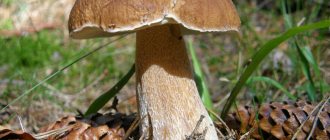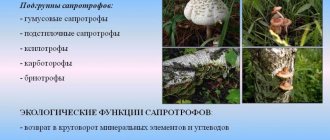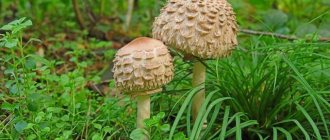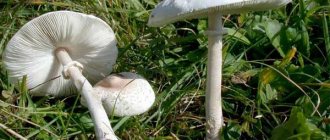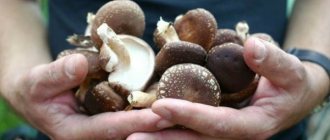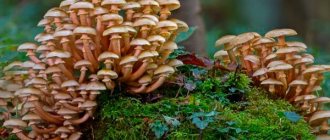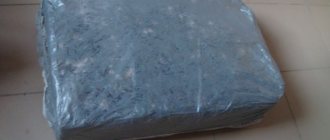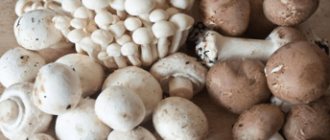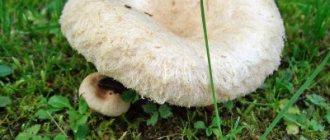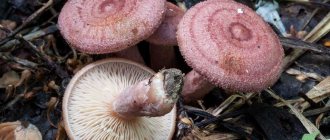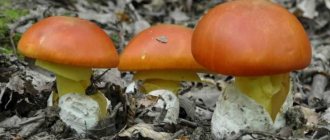Variegated umbrella mushroom (Macrolepiota procera) is a species of mushroom of the champignon family, genus umbrella mushroom, or macrolepiota (lat. Macrolepiota). A large number of mushrooms of this genus have been noted, but so far only umbrellas have been identified as edible:
- maiden;
- mastoid;
- motley (large, tall);
- white (field);
- graceful (thin);
- blushing (shaggy).
The name comes from the tall stem with a domed cap that looks like an open umbrella.
Where and how does it grow
The distribution area is incredibly vast. Found on all continents except Antarctica. The vast majority of species are typical saprotrophs, preferring open, light areas of forests and forest edges. It can also be found in garden plots, fields, steppes, meadows, parks and vegetable gardens. They grow singly or in colonies. Collected from May to October.
Variegated umbrella mushroom. Description
Although almost all adult mushrooms are shaped like an open umbrella, the umbrella mushroom truly deserves its name. In its “youth”, the mushroom looks like a folded umbrella, in which the knitting plates are tightly pressed to the “umbrella handle” leg. As they grow older, the plates move away from the stem and become horizontal, which very closely resembles the opening mechanism of an umbrella.
Even from the description of the variegated umbrella mushroom, it is clear that this is a fairly large mushroom. He's even more impressive live. The diameter of the cap is about 20-25 cm, and sometimes reaches 35 cm. The stem is on average 10 to 20 cm, although there are individuals with a height of 30-40 cm. The thickness of the stem is usually 1-2 (sometimes 4) cm. On the stem, like usually there is a small “skirt”.
On the underside of the cap there are plates 2 cm wide at the edge, which narrow as they approach the stem. The color of the plates is white; as the mushroom ages, they can become beige or cream. The stem and cap separate from each other very easily.
While the umbrella mushroom is young, the shape of the cap is spherical, which is why, for example, in Italy it is often called “drumsticks” in everyday life. As the cap grows older, it opens up and takes on its usual umbrella-shaped shape.
The skin on the cap is brownish-gray with brown “scales.” In the center, as a rule, the scales merge into a solid brown circle. While the mushroom is young, its stem has a light brown color, then it becomes a little darker and covered with dark scales, which is why rings of light and dark tones often form on the stem.
The pulp is loose and fleshy, but in old mushrooms, on the contrary, it is dense. The color is white and does not change when pressed or cut. The raw mushroom has a slight mushroom smell.
For a more complete understanding, we recommend looking at a photo of the variegated umbrella mushroom.
Inedible species
Poisonous false umbrella mushrooms contain toxic substances that have not been fully studied. The inedible poisonous umbrella mushroom has a hallucinogenic effect due to the presence of toxins in its pulp. Poisoning occurs due to the content of the following highly toxic substances:
- fallina;
- phalloidin;
- amanitina.
Fallin can be neutralized by heat treatment. Other toxic substances remain unchanged and can therefore lead to irreversible damage and death without timely assistance.
Lepiota cristata
Representatives of the species grow in temperate forests in the north. Culture prefers the European part of the continent. The cap is small, up to 5 cm in diameter. The shape is the same as a girl's umbrella. It is distinguished by the external features of a tubercle in the middle. He is small, bright red in Lepiota. The girl's umbrella has a dark mound. The scales on the cap are sparse and pointed. They are yellow or ocher in color. The ring on the stem is pinkish in color, thin, movable. When cut, the fibers of the pulp are clearly visible. The smell is pungent and unpleasant.
Lepiota cristata, photo by Barbora Batokova.
Lepiota rougha
The species is also called the sharp-scaled umbrella. It is found in Europe, Mexico, and northern Africa. The cap is fleshy, fleecy, ovoid. Grows up to 14-15 cm in diameter. It has characteristic rust-colored scales. These umbrella mushrooms have pale yellow legs with horizontal wavy brown stripes that are barely visible to the eye. The wide ring has noticeable brown inclusions on its surface. The taste of the pulp is bitter and unpleasant. The smell is pungent.
Lepiota rough.
Chlorophyllum lead-slag
The species is called false umbrella. It is found in Australia, Europe, the USA, and North Africa. The fruiting body resembles a variegated umbrella in appearance. The poisonous twin is distinguished by the following characteristics:
- pink sparse flakes on the cap;
- large cap diameter – up to 35 cm;
- the pulp becomes orange or brown when cut;
- lack of smell and taste;
- the plates are green-gray in mature mushrooms.
Chlorophyllum lead-slag.
Chlorophyllum brunneum
The forest species is common in Hungary, the USA, Croatia, and Slovenia. Prefers areas with a humid, swampy climate. Chlorophyllum dark brown, or as it is also called, chlorophyllum brown, is a poisonous mushroom that looks like an umbrella mushroom. It is just as variegated, there are scales on the surface of the cap and a ring on the stem. The main difference between chlorophyllum and an umbrella is its “stockiness” (the stem is small in length, plus quite thick and dense).
Some sources claim that this species has hallucinogenic properties, but its chemical composition has not yet been fully studied. It is known that in some people, eating it led to serious allergic and other negative reactions. This species is not found in Russia.
The brown cap of the inedible umbrella mushroom reaches a diameter of 13-14 cm. The stem changes color from beige to brown-brown. At the base of the leg there is a characteristic tuberous growth that grows up to 5-6 cm in diameter. The flesh of the fruit body is white, but when cut in air it changes color to orange-red.
Dark brown chlorophyllum (Chlorophyllum brunneum), photo by Eduard Jardí.
Variegated umbrella mushroom - edible or not?
Many good edible mushrooms have their “evil” counterparts among their poisonous counterparts. The variegated umbrella is no exception in this matter. In view of this, the old rule does not lose its relevance: take only well-known mushrooms and leave those that raise the slightest doubt.
Before you go on a “quiet hunt,” carefully study the photo and description of the variegated umbrella mushroom. In appearance, it is very similar to mushrooms from the fly agaric genus - pale toadstool and gray fly agaric. It is for this reason that many mushroom pickers, especially inexperienced ones, completely ignore the umbrella mushroom, which, given a lack of experience, is, of course, an absolutely correct tactic.
Main differences from poisonous counterparts:
- the “skirt” of the umbrella mushroom is a three-layer ring that is not attached to the stem and can easily be moved vertically;
- the edible mushroom does not have any other remnants of the “veil”, which poisonous ones always have;
- the hat of the umbrella is matte, while the cap of the fly agaric is, on the contrary, shiny and smooth;
- the fly agaric cap is covered with sparse specks, while the umbrella has more of them, and in the central part they merge into a single smooth circle;
- Toadstools can often be identified by the greenish or olive color of the cap, which is not characteristic of an umbrella mushroom.
We hope you now understand the question of whether the variegated umbrella mushroom is edible or not.
Precautionary measures.
The motley umbrella is a healthy and edible mushroom that does not contain dangerous substances that negatively affect the human body. But he has several dangerous doubles that are very similar in appearance. Let's consider what dangerous doubles can be found in the forest zone.
- Chlorophyllum is dark brown.
The mushroom is extremely rare in our latitudes, but still sometimes mushroom pickers confuse it with an edible umbrella. The problem is that the mushroom has almost identical external characteristics. The dark brown chlorophyll differs only in its size - it is slightly smaller than an umbrella, and also in the fact that at the point of cutting its flesh quickly acquires a reddish tint.
- Chlorophyllum lead-slag.
Another variety that contains toxins dangerous to human life and has an external resemblance to an edible umbrella. Chlorophyllum lead-slag is found only in America. It differs from the edible umbrella in the redness of the flesh, the green color of the spore powder and the lack of aroma.
Variegated umbrella mushroom: photos of edible and poisonous species
In addition to toadstools and fly agarics, the variegated umbrella mushroom can be confused with its other close relatives. In particular, under the guise of a harmless variegated one, you can accidentally put the purple umbrella of acutesquamosis into the basket. This mushroom can be recognized by its unpleasant odor and bitter taste. So if the cooked mushroom tastes bitter, spit it out immediately and consult a doctor immediately.
Another evil twin of the motley is the combed umbrella. Fortunately, it is quite easy to recognize it by its significantly smaller size: the diameter of the cap is only 2-5 cm. The masteoidea umbrella is slightly larger - the cap is 8-12 cm, which is already close to the norm for a variegated umbrella.
But the greatest danger is the fleshy-reddish umbrella, the consumption of which can be fatal. However, it is also distinguished by its small size - the diameter of the cap usually does not exceed 2-6 cm.
We remind you once again that if you have the slightest doubt, walk past the mushroom, no matter how tempting it may seem.
Chemical composition
The variegated umbrella contains a high level of fiber and chitin. This mushroom is considered a very valuable product due to the presence of vitamins B3, B2, PP, B9, B1, E, B6, C, K. The pulp of the fruiting body contains large amounts of:
- sodium;
- phosphorus;
- gland;
- potassium;
- calcium;
- magnesium
Representatives of this species contain up to 75% protein.
How to cook variegated umbrella mushroom
Unlike most mushrooms, which are eaten whole, when preparing the variegated umbrella mushroom, the stem is usually discarded, since it is quite tough and fibrous. But the cap, on the contrary, is very soft and fleshy.
Of course, any housewife can come up with a lot of recipes for how to cook variegated umbrella mushroom. The easiest option is to simply fry the caps in sunflower oil or stew them in sour cream. In principle, the caps can be cut into pieces so that they can be used as a classic addition to mashed potatoes. But many gourmets prefer to fry the whole caps, like pancakes. After rolling them in breadcrumbs or flour (you can add an egg), the caps are fried first on the bottom side and then on the top.
A good idea would be to use an umbrella mushroom to make soup. Also, young umbrellas are often pickled raw for the winter.
As mentioned, the fleshy soft caps are of the greatest interest, but not everyone agrees that the legs should simply be thrown away. Since in their original form they are indeed quite harsh, you can grind them in a meat grinder and, after frying in this form, add them to soup, mashed potatoes, or use them as a spread for sandwiches. Mixed with meat or mashed potatoes, grated mushroom stems can be used for dumplings or pies.
Application
For food, it is better to use young specimens of the motley umbrella (until its cap has fully opened). The caps can be fried, and the legs, since they are generally tougher, can be dried and ground for seasoning, or simply boiled in soups for flavor, remembering to remove them when the soup is ready. More mature mushrooms, with dense or hard flesh, are used for pickling and pickling, not forgetting to first thoroughly clean them of coarse scales. At a young age, it can even be consumed fresh for sandwiches and salads.
Cultivation of umbrella mushroom
The variegated umbrella mushroom belongs to the champignon family, that is, it is a close relative of the garden champignon - the same one that accounts for 80% of the world's harvest of artificially grown mushrooms. However, despite such famous relatives, the umbrella mushroom itself has not yet been “domesticated”. Although attempts to artificially grow it occur constantly, an economically feasible technology has not yet been found.
Despite the umbrella’s stubborn desire to remain a wild mushroom, it is still possible to breed it for personal purposes. Of course, we are not talking about guaranteed high yields here, but it is still possible to grow a bucket or two of these mushrooms for the family table. The main thing is to carefully study the photo of the variegated edible umbrella mushroom and its poisonous counterparts, so as not to accidentally start breeding fly agaric mushrooms.
Rules and meeting places
You can “hunt” for this mushroom from the second half of June until November. Experienced mushroom pickers know that the most suitable container for collecting forest gifts is a wicker basket, because the harvest in bags and buckets will quickly deteriorate.
Advice!
First of all, you should make sure that the umbrella you find is edible, and only then put it in the basket. Some mushroom pickers immediately inspect the mushroom for worminess, so as not to waste space in the container.
This specimen grows in almost all forests in the central zone of our country. It can even be found in vegetable gardens and forest parks.
Growing umbrella mushroom in the garden
If you suddenly don’t know, we’re happy to enlighten you that mushrooms reproduce in two ways:
- Through mycelium. This is a kind of rhizome or underground part of a mushroom colony, from which grows an above-ground part, called the mushroom itself.
- Disputes. Something like seeds (only much smaller) that ripen in the mushroom cap.
Since growing umbrellas still remains the province of individual and very few amateur gardeners, you will not be able to purchase mycelium anywhere. The only way to get it is to dig it out in the forest yourself. However, the likelihood that after transplantation it will take root in a new place is extremely low.
You won't be able to buy spores either. But you can get them yourself - in the forest. To do this, you need to find an old flabby umbrella mushroom, bring it home and sow it on the site. Sowing is carried out as follows: the mushroom cap is pinned on a tree branch or hung in another way (even on a rope) over the area where it is planned to grow mushrooms. While suspended, the mushroom dries out, and the spores inside the cap ripen and over time spill out onto the ground, sowing the area.
To ensure at least a minimal chance that the umbrella mushroom will take root on the site, you should prepare the bed accordingly. The umbrella loves calcium-rich soils, so it is worth fertilizing the garden bed with calcium carbonate. By the way, as mentioned above, the umbrella is related to champignons, and their cultivation today has been put on stream, which is manifested, among other things, by the abundance of ready-made concentrates for soil on the market. These concentrates are also suitable for umbrella mushrooms.
Where it grows, in what forests and how to collect
Tall umbrellas grow on all continents except Antarctica. In Russia there are especially many of them in the forests of the northern and central regions. They mainly grow in open places: forest edges, garden plots, fields, steppes, parks, lawns and vegetable gardens. Sometimes you can find a whole family of mushrooms, but most often they grow solitary.
On a note!
Royal champignons must be collected between May and October. Young mushrooms with unopened caps are considered the most delicious.
Growing umbrella mushroom in the forest
And yet, the variegated umbrella mushroom remains a very finicky mushroom, and therefore its successful cultivation in a personal plot will be more of a rare success than a natural result. Practice shows that cultivation attempts will be more successful if done in the area where mushrooms naturally grow, that is, in the forest.
In this case, you won’t have to make any special efforts. We just take and hang the old worm caps right above the place where we cut them off. In this way, we imitate the natural reproduction of coffins as much as possible, but only expand the sowing area. If under natural conditions mushrooms pour out all the spores under themselves, which is why only some of them can sprout, then by spraying them within a radius of several meters, you can reduce the competition between the spores, increasing the total number of shoots.
As you can see, you don’t need to make any special efforts to grow mushrooms in the forest. Simply, while we are harvesting young umbrellas, we simultaneously prick old mushrooms onto the nearest branch. Cash costs are zero. Time spent - 5-10 seconds per cap. You will be surprised, but by doing this every year during mushroom picking, you can significantly (several times) increase forest productivity.
You can learn about the features of the umbrella mushroom in the video.
The only disadvantage of this type of mushroom cultivation is that you will not be able to completely appropriate the harvest for yourself. Other mushroom pickers can rightfully pick mushrooms in a clearing that you have tended for several years, and nothing can be done about it.
Useful properties and contraindications
Despite its dubious appearance, the beneficial effect of the umbrella on the human body has been noted for a long time:
- Fighting cancer. Beta-glucans and melanin contained in umbrella mushrooms have a positive effect on the entire body and the immune system in particular. They stabilize the metabolic process and stimulate its work. This effect is a strong barrier against cancer.
- Improves the functioning of the cardiovascular system. Its use improves the functioning of the hematopoietic organs and also strengthens blood vessels. It also helps relieve heaviness from heart problems.
- Fighting depression. When used regularly, it has a beneficial effect on brain function and helps avoid anxiety and mental exhaustion.
- Normalization of the thyroid gland. The composition includes riboflavin (vitamin B2), which has a positive effect on the function of the thyroid gland, and it also protects the skin, hair, and nails.
- Establishing metabolism. The microelement PP helps accelerate metabolic processes.
- Release of “bad” cholesterol. Lecithin, which is part of the mushroom, rids the body of excess cholesterol and balances its level.
Contraindications
This representative of the mushroom kingdom is considered safe, but to avoid health problems, you need to familiarize yourself with the contraindications to its use:
- Individual intolerance.
- Increased bladder function.
- Liver diseases.
- Diseases of the intestines, stomach and pancreas.
- Children under 6 years of age and pregnancy.
How to cook
First they are subjected to heat treatment. The fruiting bodies are freed from forest debris, then washed twice in clean water. Transfer to a saucepan, add water, add salt and cook over medium heat for 15-20 minutes.
You can cook it in different ways - boiling, frying, pickling, drying and salting. They are also frozen in a plastic airtight container or plastic bag.
In this form they are stored all winter. After this, they are used to prepare soups, main courses, sauces, salads, and pie fillings.
If you decide to dry mushrooms, you must first wash them, then put them on a thread, hang them in a dry and warm room where there is no sunlight. Drying time depends on the size of the fruiting bodies.
It is best to take caps for cooking, because... the flesh of the leg is tougher.
Recipe 1. Umbrellas in batter
For preparation you will need several components:
- eggs - 2 pcs.;
- mushrooms (caps) - 10-12 pcs.;
- flour - 2 tbsp. l.;
- vegetable oil;
- salt, pepper - to taste.
First you need to prepare the batter - mix the eggs with flour, add 150 ml of water. You should get a homogeneous thick mixture without lumps. To do this, you can use a whisk or fork. Salt and pepper the thick mass and mix again.
Wash the fruiting bodies, separate the stems from the caps, dip in batter, and fry in vegetable oil until golden brown. Frying time on each side is 5 minutes.
Advice. If the caps are large, cut them into several pieces.
Recipe 2. Umbrella sauce
To prepare a spicy and very tasty sauce you will need:
- sweet pepper - 1 pc.;
- ketchup - 50 ml;
- cream (15%) - 130 ml;
- flour - 2 tsp;
- lard - 50 g;
- pickled cucumbers - 2 pcs.;
- young mushrooms - 0.5 kg;
- salt, pepper to taste.
You can prepare many dishes from mushrooms
Rinse the umbrellas, place in a colander and, after the water has drained, cut into strips, simmer in their own juice with the addition of salt, pepper and other spices (optional). After a couple of minutes of simmering, add chopped bacon. A little later, add the bell pepper cut into strips to this mass.
When the liquid has evaporated, add cream, ketchup and flour diluted with a small amount of water. Attention! When mixing flour and water, make sure that no lumps form.
Simmer for another 10 minutes, covered, over low heat, stirring occasionally. At the end of cooking, add pickled cucumbers cut into pieces and stir. Cover with a lid and let stand for 15-20 minutes.
The aromatic sauce is perfect for second courses of potatoes, rice or buckwheat.
Recipe 3. Mushroom chops
Ingredients:
- wheat flour - 6 tbsp. l.;
- mushrooms - 10 pcs.;
- vegetable oil - 5 tbsp. l.;
- salt, pepper - to taste.
Only the caps are used to prepare chops. They are separated from the legs, washed, dried, and rubbed with a mixture of salt and pepper. The pieces are rolled in flour and fried on both sides for 3-4 minutes in vegetable oil.
The dish goes well with boiled or baked potatoes.
Recipe 4. Marinated mushrooms
There is a certain technology for pickling these mushrooms, following which you will get a very tasty preparation for consumption in the off-season.
- The fruiting bodies are cleaned of debris and film, washed under running water, and cut into segments of the required size.
- Place in a stainless or enamel pan (without chips), fill with water, add salt (approximately 35-40 g per 1 liter of water). Cook over medium heat, periodically skimming off the foam. As soon as the mushrooms begin to sink to the bottom, simmer for a couple more minutes and remove from heat. Place in a colander to drain excess liquid.
- The next step is preparing the marinade. Pour 0.5 liters of water into a saucepan, add 1 tsp. salt, 3 g citric acid.
- In another container you can sterilize jars for future preparations or bake them in the oven. Disinfect together with lids.
- You can add any spices and pepper to the boiled marinade if desired. Turn off, pour in 5 tbsp. spoons of 6% table vinegar, stir.
- Place boiled mushrooms in clean containers. Pour hot brine to the very top, so that the mushrooms are completely covered.
- Place in a large saucepan with water and sterilize for 40 minutes over low heat. Roll up, cool and store in a cool place (cellar or basement).
It is allowed to eat the preparation only a month after rolling. During this time, it will have time to absorb all the aromas.
Benefits for the body
Large lepiota has excellent taste. That is why many mushroom pickers purposefully go for it. It is better to collect and use mushrooms when they are young. Only in this case they contain a huge amount of vitamins and nutrients. They are preserved even after heat treatment. The properties are preserved after marinade, salting and drying.
What substances does the umbrella mushroom contain?
- B vitamins.
- Vitamin C.
- Vitamin E.
- Vitamin K
- Tyrosine.
- Beta glucans.
- Potassium.
- Calcium.
- Magnesium.
- Phosphorus.
- Iron.
- Sodium.
- Melanin.
That is why, in ancient times, local healers actively used lepiota majora to prepare tinctures and extracts in order to eliminate serious ailments. Indeed, the mushroom helps fight the following types of diseases:
- oncology;
- rheumatism;
- diseases of the heart and blood vessels;
- various nervous system disorders.
How to use mushroom to benefit your health?
Yes, this is what you need to know, how to make a tincture recipe.
It can be used in the treatment of diseases, as well as for general strengthening of the body and boosting immunity.
For cooking you will need 700 g of mushrooms.
- They need to be washed well, dried and finely chopped.
- Then take 500 ml of vodka.
- Pour liquid over mushrooms.
- If necessary, add a few small capsicums.
- Store the tincture in a cool, dark place for 2-3 weeks.
- After this time, it can be actively used.
For example, do rubbing, massage, and also add to food.
Of course, such treatment methods can only be carried out if you are sure that such therapy is not contraindicated for you.
